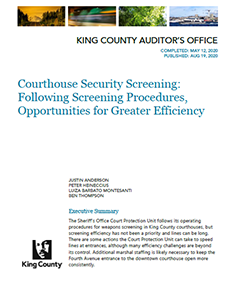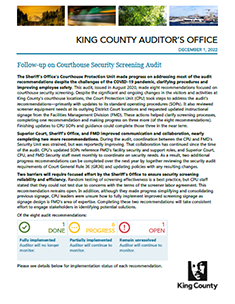Courthouse Security Screening: Following Screening Procedures, Opportunities for Greater Efficiency
August 19, 2020
NEW! Download the latest follow-up report
Note: This audit was conducted prior to the COVID-19 pandemic. To the extent that the pandemic has changed operations at the King County Courthouse and the Maleng Regional Justice Center, some audit findings may be inapplicable unless or until operations return to normal.
The Sheriff’s Office Court Protection Unit follows its operating procedures for weapons screening in King County courthouses, but screening efficiency has not been a priority and lines can be long. There are some actions the Court Protection Unit can take to speed lines at entrances, although many efficiency challenges are beyond its control. Additional marshal staffing is likely necessary to keep the Fourth Avenue entrance to the downtown courthouse open more consistently.
Status
Of the 8 recommendations:
| DONE | 1 | Recommendations have been fully implemented. Auditor will no longer monitor. |
|---|---|---|
| PROGRESS | 6 | Recommendations are in progress or partially implemented. Auditor will continue to monitor. |
| OPEN | 1 | Recommendations remain unresolved. Auditor will continue to monitor. |
| CLOSED | 0 | Recommendation is no longer applicable. Auditor will no longer monitor. |
Summary
We observed thousands of patrons entering King County's courthouses during this audit, and the security screeners and marshals consistently carried out their duties as described in their standard operating procedures. While screeners have a limited ability to reduce lines, efficiency has not been a clear priority when setting screening policies. Changes to signage and procedures could help speed up the lines. Employees were not significantly faster than the public, so employee-only entrances may not increase efficiency. The physical layout of entrances can limit the effectiveness and efficiency of screening, since most courthouses were built before screening began.
We did not find records of any instance where a weapon had been used to attack another person inside a courthouse, since screening began in 1995; however, the effectiveness of the Sheriff's Office Court Protection Unit is rarely measured using random testing after a screener's initial training. The Washington State Supreme Court mandates security standards, but it is unclear who is responsible for implementation.
With current staffing, our model predicts the Fourth Avenue entrance to the King County Courthouse could remain open around 88 percent of the time. This is because an entrance cannot be open without a marshal, and marshals can be called away to perform other duties. Our model predicts that the County has hired sufficient screeners to keep the Fourth Avenue entrance open around 97 percent of the time, but additional marshals would be required to achieve this level of service.
We recommend implementing statewide standards, increasing testing rigor, and identifying equipment needed by screening staff. We also recommend improving signage to help speed up how long it takes to get through screening, and consistently using procedures that keep the line moving.
Reports related to this audit
Currently, there are no related reports to this project.
Audit team
Justin Anderson, Peter Heineccius, Luiza Barbato Montesanti, and Ben Thompson conducted this audit. If you have any questions or would like more information, please call the King County Auditor's Office at 206-477-1033 or contact us by email at KCAO@kingcounty.gov.

 Translate
Translate

